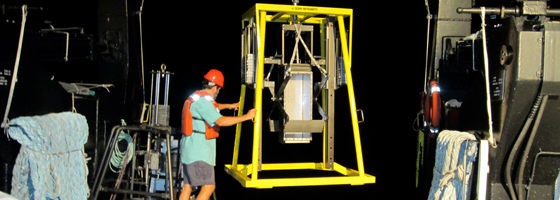Extensive Lake Huron study sets stage for seasonal monitoring

A five-project study is providing Great Lakes researchers the ability to understand the ecology of Lake Huron to help manage water quality and fisheries in the lake. The research will allow for a stronger understanding of how the lake functions and serve as a foundation for a monitoring program to see how the lake is changing throughout different seasons of the year.
The research is a collaborative effort through the Lake Huron Cooperative Science and Monitoring Initiative that includes scientists from the NOAA Great Lakes Environmental Research Laboratory (GLERL), the EPA, the USGS Great Lakes Science Center, Environmental Canada, and the University of Michigan.
The five sub-projects in the research include: (1) mapping of bottom-dwelling organisms, (2) structure and function of the open water food web, (3) phosphorus deposition in Saginaw Bay and Lake Huron, (4) structure and function of bottom-dwelling communities, and (5) physical measurements. Each project allows for a collective understanding of the lake’s ecosystem.
“If you don’t understand something, you can’t manipulate the system,” said Henry Vanderploeg, research ecologist at GLERL. “This is pretty much stuff we need to know to both manage the water quality and fisheries simultaneously.”
To understand both aspects, researchers assess trends in lake-wide, bottom-dwelling populations, including invasive zebra and quagga mussels. This is done by a standard Ponar grab sent down to scoop up sediments, which are later screened to observe for organisms.
“Mussels or other animals are captured and then preserved and later on looked at under a microscope,” Vanderploeg said. “This will allow us to determine how many species and (their) size so we can estimate the biomass. We want to know how much of everything is out there.”
Researchers are also focusing on underwater life at Thunder Bay. This research focuses on sampling organisms in areas with a rocky lake bottom by sending divers down to scrape materials off of hard substrates.
“In this (project) we’re looking at animals, especially quagga mussels, in terms of filtering particles (phytoplankton and detritus) and recycling nutrients.” Vanderploeg said.
Filtering the phytoplankton removes it from the base of the food web, starving the other animals that feed on it. Removal of phytoplankton and other particles from the water makes it clearer, allowing more light to reach the bottom. Increased light and the nutrients excreted by the mussels encourage growths of nuisance bottom plants such as Cladaphora. These plants often wash up on shore to become beach muck.
Vanderploeg and his team are also studying organisms living in the water column. Studying the structure of the open water food web allows researchers to know where are most species are at a given time.
“(We) will examine the distribution of plankton, fish larvae, juvenile fish, and adult fish and relate shifts in these species to changes (in water clarity and phytoplankton concentration) brought about by invasive zebra and quagga mussels,” Vanderploeg said.
The team uses special sensors on their ship to record the organism distribution and several other variables along its path. The vessel lowers and raises a plankton survey system through the water as the boat moves along. It records variables such as light sensitivity, chlorophyll, colored organic matter, and temperature, he said.
Along with finding out how the ecosystem works, the researchers also hope to find out why the offshore food web suffers from too few nutrients. Vanderploeg said by collecting sediment samples from Saginaw Bay, and other parts of the open lake, his team will be able to better understand nutrient flow from Saginaw Bay into open Lake Huron. They believe that after the mussels invaded Saginaw Bay, less nutrients flow from the bay to the open lake. His team uses a sediment tube to suck up and test the phosphorus deposition over time in the bay. By doing this, they can see what nutrients are making it into the lake and which are getting deposited into the sediment of Saginaw Bay.
Finally, researching changes in climate is also key to understand how the ecosystem works. The team will deploy current meters and buoys to provide real-time observations of winds, temperature, waves, and currents.
In addition, the researchers deployed a string of temperature sensors in the deepest part of the lake to provide temperature records from top to bottom throughout the year. It is intended that this site will be monitored over the years to see how weather and climate affect the lake. This is important for detecting climate change and for understanding the effect of temperature on the ecology of the lake.
Top image: Box corer sediment sampler in Lake Huron aboard the R/V Lake Guardian, July 2012. (Credit: NOAA)





0 comments